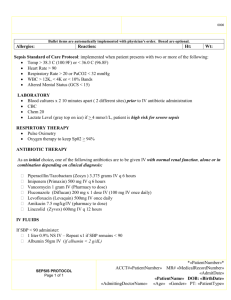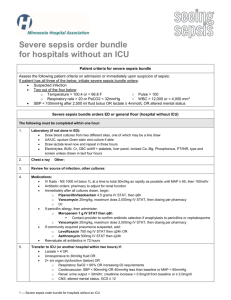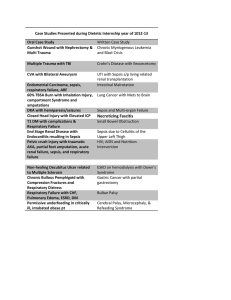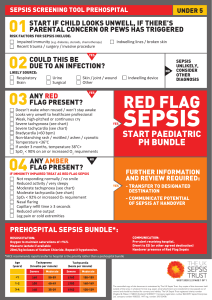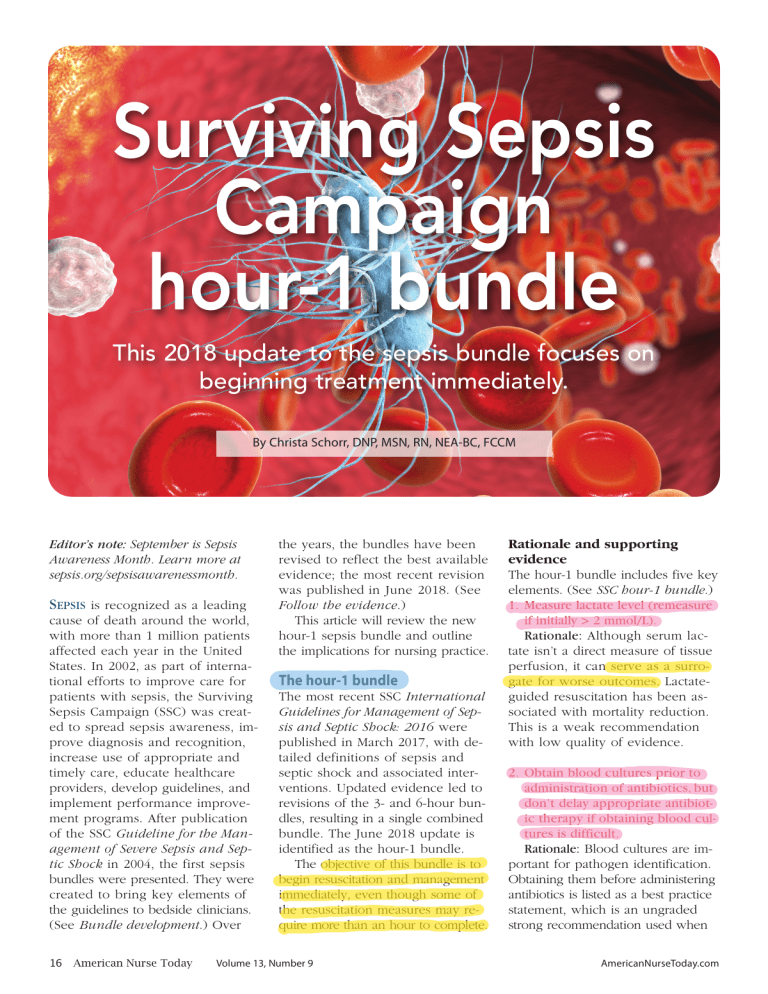
Surviving Sepsis Campaign hour-1 bundle This 2018 update to the sepsis bundle focuses on beginning treatment immediately. By Christa Schorr, DNP, MSN, RN, NEA-BC, FCCM Editor’s note: September is Sepsis Awareness Month. Learn more at sepsis.org/sepsisawarenessmonth. SEPSIS is recognized as a leading cause of death around the world, with more than 1 million patients affected each year in the United States. In 2002, as part of international efforts to improve care for patients with sepsis, the Surviving Sepsis Campaign (SSC) was created to spread sepsis awareness, improve diagnosis and recognition, increase use of appropriate and timely care, educate healthcare providers, develop guidelines, and implement performance improvement programs. After publication of the SSC Guideline for the Management of Severe Sepsis and Septic Shock in 2004, the first sepsis bundles were presented. They were created to bring key elements of the guidelines to bedside clinicians. (See Bundle development.) Over 16 American Nurse Today the years, the bundles have been revised to reflect the best available evidence; the most recent revision was published in June 2018. (See Follow the evidence.) This article will review the new hour-1 sepsis bundle and outline the implications for nursing practice. The hour-1 bundle The most recent SSC International Guidelines for Management of Sepsis and Septic Shock: 2016 were published in March 2017, with detailed definitions of sepsis and septic shock and associated interventions. Updated evidence led to revisions of the 3- and 6-hour bundles, resulting in a single combined bundle. The June 2018 update is identified as the hour-1 bundle. The objective of this bundle is to begin resuscitation and management immediately, even though some of the resuscitation measures may require more than an hour to complete. Volume 13, Number 9 Rationale and supporting evidence The hour-1 bundle includes five key elements. (See SSC hour-1 bundle.) 1. Measure lactate level (remeasure if initially > 2 mmol/L). Rationale: Although serum lactate isn’t a direct measure of tissue perfusion, it can serve as a surrogate for worse outcomes. Lactateguided resuscitation has been associated with mortality reduction. This is a weak recommendation with low quality of evidence. 2. Obtain blood cultures prior to administration of antibiotics, but don’t delay appropriate antibiotic therapy if obtaining blood cultures is difficult. Rationale: Blood cultures are important for pathogen identification. Obtaining them before administering antibiotics is listed as a best practice statement, which is an ungraded strong recommendation used when AmericanNurseToday.com Bundle development The original sepsis bundles were developed by the Surviving Sepsis Campaign (SSC) in collaboration with the Institute for Healthcare Improvement. The goal was to make the International Guidelines for the Management of Severe Sepsis and Septic Shock easier to execute at the bedside. 2004 The initial sepsis bundles incorporated a two-phased approach using the 6-hour resuscitation bundle and the 24-hour management bundle, measuring 11 quality indicators. 2012 2014 Evidence cited in the 2012 SSC guidelines supported removal of the 24hour bundle, which resulted in the 3- and 6-hour bundles measuring seven quality indicators. Both the original 6- and 24-hour bundles and the revised 2012 sepsis bundles were widely adopted in hospitals around the world. Revisions in 2014 were prompted by results of three large randomized controlled trials evaluating protocol-based care in septic shock. Researchers concluded that routine use of central venous catheters (CVC) and hemodynamic monitoring aren’t required to achieve adequate initial resuscitation of septic shock, resulting in a revision to the 6-hour bundle. CVCs are no longer required, but are one of many options to guide initial resuscitation. Follow the evidence Substantial international evidence has demonstrated that implementing the Surviving Sepsis Campaign (SSC) sepsis bundles is associated with improved outcomes. In a single-center U.S. study, investigators described a severe sepsis and septic shock mortality reduction to less than 10% with improved bundle compliance. Similar results were observed in other countries, including Spain and the United Kingdom. Results of the sepsis bundle implementation over 7.5 years found that participation in the quality improvement program was associated with decreased mortality and reduced hospital costs. Hospitals with higher bundle compliance showed reductions in intensive care unit and hospital length of stay. Developing countries, including India, Brazil, and China, reported the same. Evidence for the clinical benefit of the bundles increased public awareness and raised national interest. The 3- and 6-hour bundles were adopted by the National Quality Forum in 2012 and the New York State Department of Health in 2014. In 2015, the Centers for Medicare & Medicaid Services mandated hospital reporting of the early management of sepsis and septic shock (Core Measure SEP-1), which closely follows the 3- and 6-hour SSC bundles. port the 30 mL/kg fluid dose, several interventional and observational studies provide support. Evaluate and assess fluid responsiveness before administering additional fluid beyond the 30 mL/kg dose. 5. Apply vasopressors if the patient is hypotensive during or after fluid resuscitation to maintain mean arterial pressure (MAP) ≥ 65 mm Hg. Rationale: Restoring perfusion pressure to vital organs is essential. Vasopressor administration in a hypotensive patient is graded as a strong recommendation with moderate-quality evidence. Nursing implications the benefit or harm is certain but the evidence is difficult to summarize. quired; discontinue antimicrobials if no infection exists. 3. Administer broad-spectrum antibiotics. Rationale: Adherence to early antibiotics and antibiotic stewardship are important to provide high-quality care. Administering broad-spectrum antibiotics with one or more I.V. antimicrobials is a strong recommendation with moderate quality of evidence. Administer narrowspectrum antimicrobial therapy after the pathogen and sensitivity are ac- 4. Begin rapid administration of 30 mL/kg crystalloid fluids for hypotension or lactate ≥ 4 mmol/L. Rationale: Sepsis patients with tissue hypoperfusion or septic shock require early fluid resuscitation. Administration of 30 mL/kg of crystalloid for hypotension or lactate ≥ 4 mmol/L is graded as a strong recommendation with low quality of evidence. Despite the lack of controlled studies to sup- AmericanNurseToday.com Nurses are instrumental to improving outcomes for patients with sepsis or septic shock. They can provide early recognition of signs and symptoms, implement treatment, help remove barriers to care, and promote education. Recognizing signs and symptoms As nurses interact with patients in a wide variety of settings—emergency departments, intensive care units, medical/surgical units, skilled nursing facilities, the community, homes, and medical offices—they’re likely September 2018 American Nurse Today 17 SSC hour-1 bundle The goal of the Surviving Sepsis Campaign (SSC) hour-1 bundle is to begin resuscitation and management immediately. Reproduced from survivingsepsis.org. Copyright ©2018 Society of Critical Care Medicine and the European Society of Intensive Care Medicine. 18 American Nurse Today Volume 13, Number 9 AmericanNurseToday.com Educational resources Educational resources and tools are available at survivingsepsis.org. (See Educational resources.) Use these resources to promote education about the Surviving Sepsis Campaign (SSC) hour-1 bundle. Intensive Care Medicine: The Surviving Sepsis Campaign Bundle: 2018 Update Quality, timely treatment Sepsis bundles are designed for bedside application of key elements of the SSC guidelines and promote the importance of appropriate and timely treatment. The 2018 hour-1 bundle update focuses on five elements within a single sepsis bundle. Nurses are instrumental in early sepsis identification and patient management. Adhering to their role in providing quality timely treatment will result in better patient outcomes. This video provides an overview of the new hour-1 bundle. youtube.com/watch?v=y8b20TMA-7Q SSC Hour-1 Bundle infographic Download this infographic to share with colleagues and your organization’s leadership. survivingsepsis.org/SiteCollectionDocuments/Surviving%20-Sepsis-Hour1-Bundle-Infograph.pdf SSC hour-1 bundle pocket card Download and print this pocket card to keep with you as a reminder of the five elements of the new hour-1 bundle. survivingsepsis.org/SiteCollectionDocuments/Surviving-Sepsis-CampaignHour-1-Bundle-2018-Print-Card.pdf to encounter patients with signs and symptoms of sepsis. Prompt recognition is an important step in sepsis management, and some organizations have shown that specialty trained sepsis rapid response teams lead to improved patient outcomes. Implementing treatment After confirming a sepsis diagnosis with the provider, the nurse should collaborate with others to initiate guideline-recommended treatment. Sepsis bundle interventions are implemented in the form of an orderset, protocol, pathway, or care plan. Screening and monitoring patients with sepsis may differ from hospital to hospital and even from unit to unit because of the nature of the patient population. Follow your organization’s protocol, and review protocols and care plans to see if updates based on the new hour-1 bundle are indicated. Several studies have demonstrated that nurse-driven protocols are effective in improving adherence to SSC guideline recommendations; implement protocols that align with your state’s practice acts. Whether you work in the acute or post-acute care setting, it’s essential to be aware of the hour-1 bundle elements and to promote prompt implementation. AmericanNurseToday.com Visit americannursetoday.com/?p=50812 for a complete list of selected references. Nurses are Christa Schorr is an associate professor of medicine at Cooper Medical School of Rowan University and a clinical nurse scientist—critical care at Cooper University Hospital in Camden, New Jersey. instrumental to improving outcomes Selected references De Backer D, Dorman T. Surviving sepsis guidelines: A continuous move toward better care of patients with sepsis. JAMA. 2017; 317(8):807-8. for patients with sepsis or Ju T, Al-Mashat M, Rivas L, Sarani B. Sepsis rapid response teams. Crit Care Clin. 2018; 34(2);253-8. septic shock. Removing barriers In addition to delayed recognition of sepsis, barriers to sepsis bundle implementation include lack of knowledge, resources, staff, and informatics support. The organizations most successful at managing sepsis are those with senior leadership backing, physician and nursing staff engagement, and informatics support. Promoting education A sepsis education program that includes guidance for sepsis screening, a process to communicate findings, and knowledge of the hour-1 bundle components will keep nurses up-todate. Staff should know what to do and why; understanding why provides motivation for timely appropriate treatment to patients with sepsis. Kleinpell R. Promoting early identification of sepsis in hospitalized patients with nurse-led protocols. Crit Care. 2017;21(1):10. Levy MM, Rhodes A, Phillips GS, et al. Surviving Sepsis Campaign: Association between performance metrics and outcomes in a 7.5-year study. Intensive Care Med. 2014; 40(11):1623-33. Levy MM, Evans LE, Rhodes A. The Surviving Sepsis Campaign bundle: 2018 update. Crit Care Med. 2018;46(6):997-1000. Mukherjee V, Evans L. Implementation of the Surviving Sepsis Campaign guidelines. Curr Opin Crit Care. 2017;23(5):412-6. Rhodes A, Evans LE, Alhazzani W, et al. Surviving Sepsis Campaign: International guidelines for management of sepsis and septic shock: 2016. Crit Care Med. 2017;45(3):486-552. Schorr C, Odden A, Evans L, et al. Implementation of a multicenter performance improvement program for early detection and treatment of severe sepsis in general medical-surgical wards. J Hosp Med. 2016;11(suppl 1):S32-9. September 2018 American Nurse Today 19

